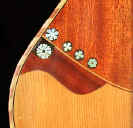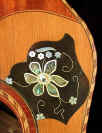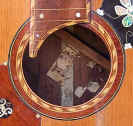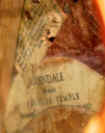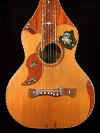
Click on a
picture to enlarge
(images copyright Gregg Miner)


There
inevitably must come a time with Knutsen instruments when “fancy”
turns to “garish.”
This may be that time.
There is a reason, however, for the patchwork quilt of excessive,
ill-placed inlays all over this guitar. The details tell a pretty clear,
but highly unusual story…
This
instrument clearly started out as a left-handed harp Hawaiian, with
the common 2 basses and 4 trebles.
It was then re-configured to become a right-handed harp Hawaiian,
with the same stringing pattern (now reversed).
Finally, it was modified again into it’s current state – a
right-handed six-string.
The fascinating thing is – all the modifications appear to have been
made by Knutsen himself! And, as it is probably one of the later models,
it must have been done in a relatively short span of time.
Evidence:
Version 1. The left-handed beginnings are first evident in the main koa and
mahogany sections of the top. They are a mirror image of (most)
right-handed specimens. By the way, I haven’t yet pointed out that, on
all these and similar instruments, these contrasting wood sections are not
inlaid into the top, but are the top, fitted like giant puzzle
pieces suspended in space (how the top survives or produces a decent tone
is just another part of the Knutsen mystique!). These design elements
aside, the fingerboard extension is also a reverse of all right-handed
specimens (i.e. always on the treble side). Clearly, this guitar was
initially intended for a left-handed customer. An aside: it’s not
known whether left-handed Chris Knutsen played steel guitar in addition to
harp guitar. The standard harp arm was attached to the right side of
the upper neck – apparently with 3, rather than the normal 2, screws.
The holes are simply plugged (cosmetically disguised) with bridge
pins. Underneath the current Knutsen-made bridge, the holes for the two
bass strings remain. Strangely, there were two sets of
treble string pins (on the left side of the body for the original
“lefty” configuration) – all the holes are still visible from
inside. The upper and lower 4-hole rows of each set are adjacent to each
other. One set was filled with round pearl inlays and filler (note that
all original or replaced inlays are from Knutsen’s recognizable stash of
“flower” and “snowflake” patterns). The other set was covered by
solid wood inlaid designs (the lower with strange inlays matching the
“pickguard”). For this first version, there would have been a
different nut and bridge.
Version
2. For whatever reason (perhaps losing the left-handed customer), the
guitar was next modified into a right-handed version of the same 12-course
harp Hawaiian. The screw and pin holes were hidden or “disguised” as
discussed above, and the old bridge was replaced by a shape
similar to the existing bridge (a slight indentation of a similarly
shaped, but slightly smaller bridge can be seen with the current bridge
removed). A new bass harp arm was attached on the
left side, where again, the screw holes were later plugged with bridge
pins. The new “pickguard” was probably added at this time, and is
inlaid into the top. Of unknown wood, this piece is inlaid with a similar “pre-psychedelic” flower design (made of abalone, pearl and, for the
thin pieces, celluloid) as HHW14. This time, the tail end of the trebles
attached to the bridge (as on HHW7, which coincidentally has an identical bridge
design!) – the holes are visible from inside (and underneath the
current bridge), and are interspersed
among the older left-handed bass string holes. The four upper end pins were
inserted into the pickguard area, and were subsequently filled/disguised
with more "flower" inlays.
Version
3. I’m not sure why Knutsen (or his new customer) still was not
satisfied, but the decision was made to remove all the harp strings, plug
and disguise this second set of holes, and pretend it was supposed
to be a 6-string all along. Other players might have simply ignored or
removed the strings, but Knutsen went to great lengths to try to turn it
into an “original” 6-string, including installing a third, unblemished
bridge (note that it is, of course, inappropriately shaped for a 6-string
bridge. He was necessarily hiding the harp string holes and marks of the
identical earlier bridge).
Other
features and comments:
Size: This is the widest yet of Knutsen's
"Weissenborn-shaped" Hawaiians - the lower bout is almost a
quarter inch over the next largest. Similar to the short and squat HHW16,
it also has an even shorter scale - nearly two inches shorter than the
25" average.
Funny headstock: The
headstock probably suffered damage to the end, ergo someone created a new
“cut-out” design to clean it up, additionally painting both sides
black. I plan to recreate it as close to original as possible.
Fingerboard:
My guess is that the guitar started out as a fairly tasteful “fancy”
model, with minimal celluloid dot and pearl “snowflake” inlays. As the
substantial amount of additional “disguising” inlay was added, Knutsen
probably kept throwing more on the fingerboard, to keep up. It’s a
pretty strange, asymmetrical mix of shapes and materials.
Soundhole: Again, Knutsen uses the unstable "puzzle-piece"
part-of-the-top construction. Note how the innermost koa ring is deliberately
out-of-round. Rather cool!
Back: A couple more inlay touches, very rare on the backs of Knutsen
instruments.
Label: Missing. Again, the instrument has features of the presumably later
Temple Street period and last McDuff Street instruments. Remnants of a
handwritten tuning guide are currently visible through the soundhole.
Stranger yet are the cut-up portions of a religious bulletin glued here
and there inside the top. They were put in from the beginning, as both
sets of lower left-side treble pin holes are drilled right through the
paper. Was Knutsen “cheaping out” again and simply using any material
at hand as “seam tape”? Overall, the insides of this guitar are about
as sloppy and embarrassing as anything Knutsen’s done.
Provenance: None, unless the "Glendale Branch of the Angelus Temple" glued inside is a clue.
I find the modern story pretty interesting however. Somehow, this
Knutsen sat unidentified and unsold for over three years in San
Francisco's Guitar Center (with an extremely reasonable sticker price
yet!). Finally, after becoming familiar with some of the specimens in the
Knutsen Archives, John Bushouse (who owns the Dunn tenor harp-uke on the
Similar Instruments page) put two and two together and sent in some quick
photos. He and I (and G.C.) quickly worked out a deal - I couldn't let
this one get away!
Conceivably,
one could easily re-configure this instrument back to either a right or
left-handed harp Hawaiian, and I’ve toyed with the idea. For now, I’d
like to preserve the evidence of what I believe is an original all-Knutsen
story.
You gotta love it!


